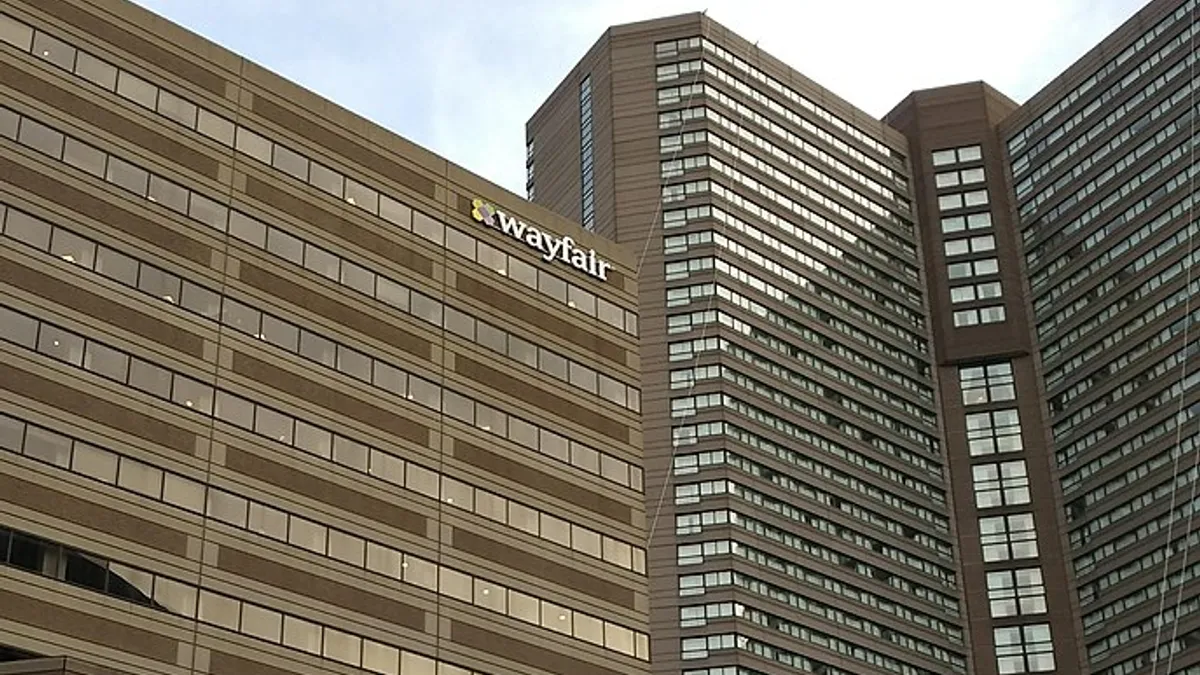Dive Brief:
- Citing a slowdown in e-commerce, Wayfair on Friday announced it is laying off 870 employees, representing 5% of its global workforce and about 10% of its corporate staff, according to a filing with the Securities and Exchange Commission.
- The layoffs, which are part of a previously announced plan to manage operating expenses, will result in $30 million to $40 million in costs, primarily in the third quarter, related to employee severance and benefits. The costs do not include stock-based compensation.
- The retailer is also in the process of making “substantial reductions” to its third-party labor costs, per the filing.
Dive Insight:
Joining other retailers who have laid off staff in recent weeks, Wayfair is reducing its corporate workforce in an attempt to manage costs.
Already this month Walmart, Best Buy, Glossier, Allbirds, Warby Parker and others have announced plans to reduce headcount.
“Over the past few years, we’ve grown Wayfair significantly to keep pace with the e-commerce growth in the home category. We were seeing the tailwinds of the pandemic accelerate the adoption of ecommerce shopping, and I personally pushed hard to hire a strong team to support that growth,” Wayfair CEO Niraj Shah wrote in a note to employees on Friday. “This year, that growth has not materialized as we had anticipated. Our team is too large for the environment we are now in, and unfortunately we need to adjust.”
The company said the staff reductions will fall into three categories: reducing management layers, aligning its work to align with its strategic priorities and making adjustments to accommodate for areas growing “faster than our current revenue trajectory can support.”
Affected employees will have access to severance based on geography, tenure and level, which includes a payout of first quarter corporate bonuses for those eligible, the company said.
Wayfair received a boost during the early months of the pandemic — and even reached profitability briefly — as consumers actively sought out goods for their home. But as consumers shifted spending to other areas, like dining out and experiences, and more recently have pulled back on discretionary spending in the face of inflation and economic uncertainty, Wayfair’s sales have declined and its losses have grown.
The online home retailer earlier this month reported second quarter net revenue fell nearly 15% year over year to $3.3 billion, while U.S. revenue fell almost 10% to $2.8 billion. Wayfair’s customer base also fell by 24.1% to 23.6 million and order per customer fell to 1.85 from 1.96 in the year-ago period. The company in the quarter also swung into the red: Wayfair reported a $378 million net loss from a net income of $131 million last year and a $372 million operating loss from an operating income of $146 million.
William Blair analysts Phillip Blee and Dylan Carden in an Aug. 4 note wrote that they expected elevated scrutiny around Wayfair’s operating costs, including its headcount.
“We are actively navigating Wayfair towards a level of profitability that will allow us to control our own destiny, while still investing aggressively in the future. We’ve prioritized our work and set clear goals: to focus on the basics, drive cost efficiency and earn more customer and supplier loyalty,” Shah wrote. “This macro environment doesn’t change our belief in the size of the opportunity ahead, and we are moving purposefully to seize that opportunity.”












